
Sprague Black Beauty
We conclude our tone cap journey with a guide to the most common types.
Let's look at the different tone caps to make it easier for you to make the right choice. Knowing the correct value makes the process even easier and less expensive, because you can buy one cap of each type to try them out. Imagine buying all available caps in all values – the time and money saved is worth spending some time with our cardboard chart!
There are no hard and fast rules as to what cap to use – there are no good or bad ones. "Good" is what you like; if super-cheap, 2-cent mini ceramic caps sound good to your ears, there is no problem with that. I've seen some odd things inside guitars over the years, so experiment. One general rule to follow, however, is to use standard, non-polarized film and foil caps. Polarized electrolytic caps don't sound very good as a tone cap.
Some tone caps seem to be more common than others, so I've prepared a guide to these. Most of the information is based on my experiences or advice from customers. If you have any special questions about tone caps, feel free to contact me.
Sprague "Black Beauties"
These, together with the "Bumblebee" caps, are definitely the most discussed caps, with an almost magical touch to them. They are usually from the late fifties or early sixties and can be found in a lot of guitars from that era. They are famous for their use in '58 and '59 (Burst) Les Pauls, and some say that they are responsible for the magical tone of those guitars. The Black Beauties can be found with red and yellow print, and the 400 and 600 volt types are the ones most often found inside guitars from that time.
These caps tend to dampen some high-end, making the tone softer, smoother, warmer or sweeter. The bass frequencies are also smoothed out, providing familiar sounds from recordings of that era. These caps are for those looking for the old vintage Les Paul tone, and they can be found at NOS or used on eBay. The only replicas I know of are from LUXE, but keep in mind that these replicas will sound different, like newer bumblebee caps. If you want to use the vintage caps, make sure that you use vintage cloth wire inside your guitar and the Gibson fifties vintage wiring, otherwise you will not fully experience the tones from these caps.
"Bumblebee" caps
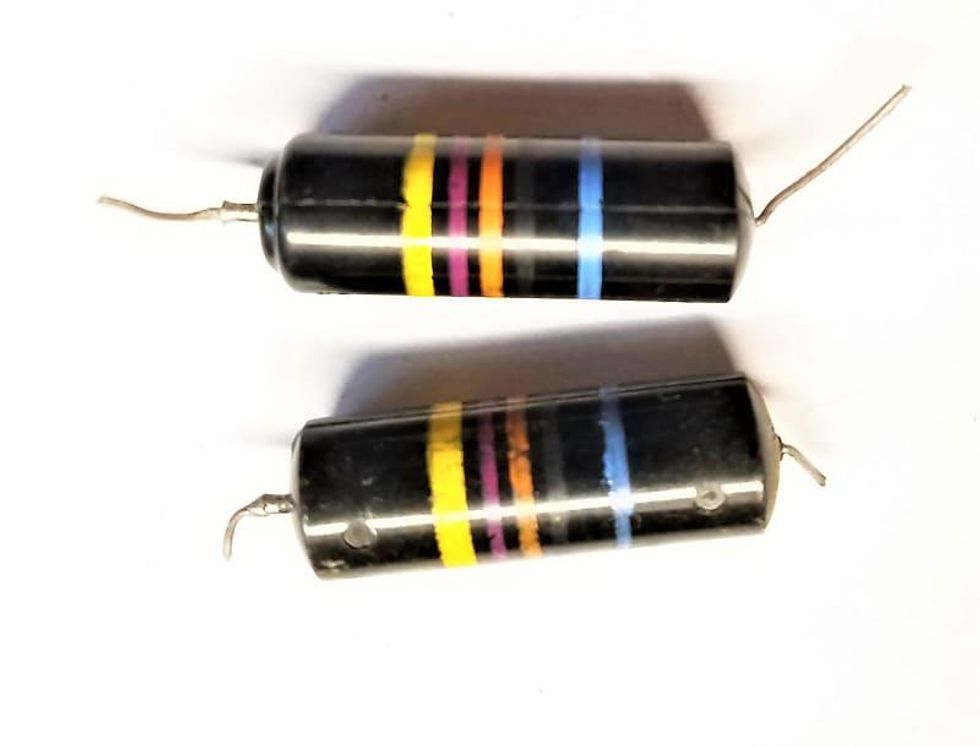
The bumblebee caps are very similar to the Black Beauties, and the origin of the nickname is pretty easy to see. You can also find these caps inside late-fifties Les Pauls and other guitars from that era, and they are definitely the most famous tone caps. Everything written about Black Beauties applies equally to bumblebee caps. Replicas are available from LUXE, Crazy Parts, and singlecoil.com.
One thing to be aware of is the Gibson "replicas" from their Historic series. These caps only look like bumblebees; I x-rayed and also opened some of them, and inside there is a cheap, standard film cap, masked with a Bumblebee cover.
"Tropical Fish" caps
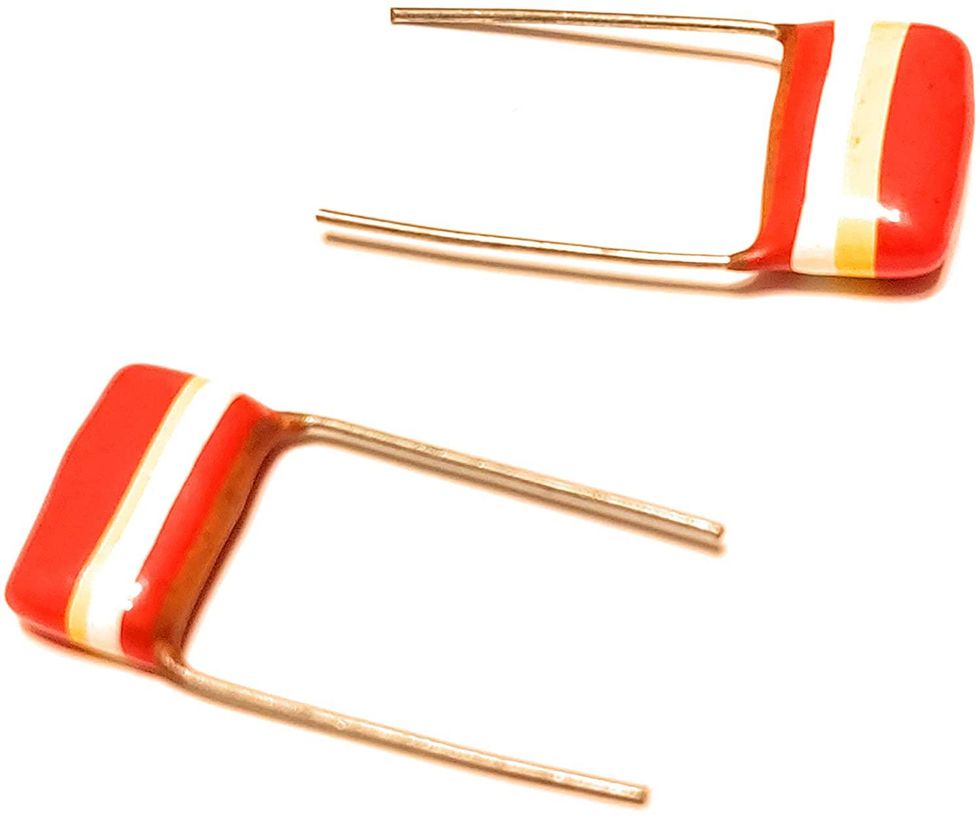
These caps are called "tropical fish" because of the colored stripes that look a bit like a tropical fish. The "tropical fish" are often mixed up with the "bumblebee" caps, but this is simply wrong. You can find the tropical fish caps mostly inside old vintage stompboxes, wah pedals and amps, but they can also be found inside some guitars. I really like these as tone caps because they offer a very fat tone, without turning the tone into mud. These caps are no longer in production, so you can find them on eBay or from vintage parts dealers. R.G. Keen from Visual Sound investigated these caps and found that they are standard film caps that are just painted funny -- very similar to the cheap "Greenies" from Xicon, so give them a try.
"Flat Disc" (ceramic) caps
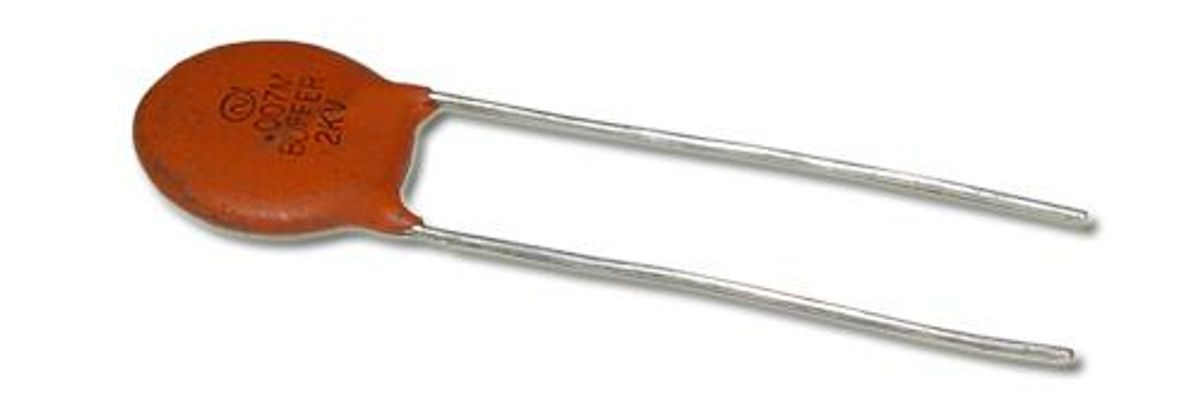
These are the old "high voltage" ceramic disk caps from Sprague or Erie that are found in almost every vintage Fender guitar. You can also find them inside old stompboxes and amps. They sound very different from modern ceramic caps and add a special flavor to the tone. If you are looking for a typical sixties vintage Fender tone, you should try these caps. From time to time, you can find originals on eBay, and replicas are available from LUXE. Another option is to get some consumer electronic devices from this era, like old TVs, radios, etc., and cannibalize from there. Often you can find them for free!
Sprague "Orange Drop" caps
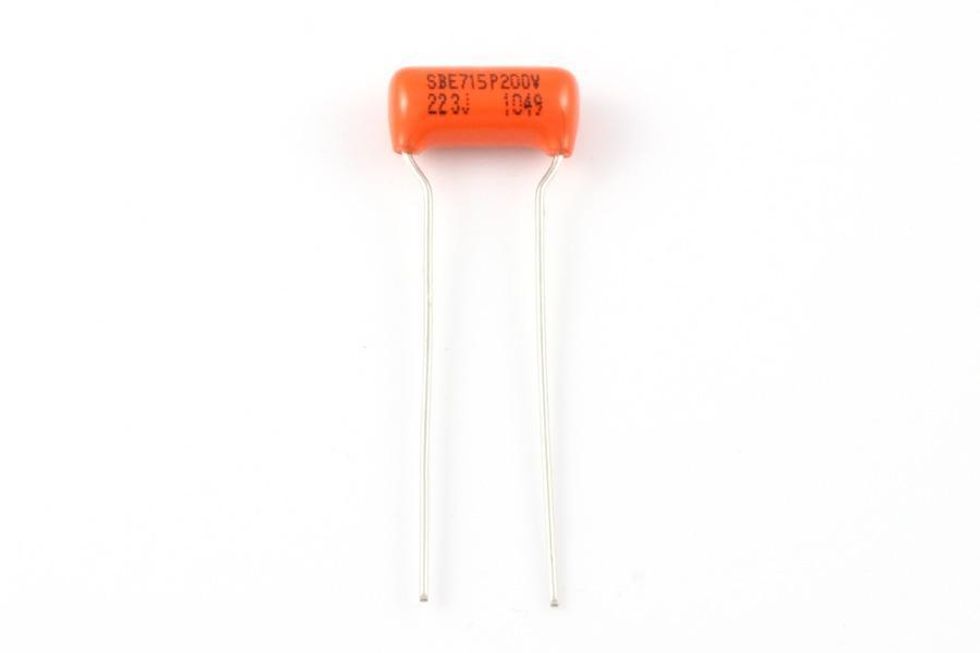
These caps are still available today from Sprague/Vishay and can be found in some high-quality guitars from PRS or Gibson. You can find old Sprague Orange Drops in a lot of old Fender guitars. The higher voltage values can also be found inside high-quality amps today, as well as in a lot of vintage Fender amps. This is another tone cap that I really like; it's very transparent and tends to pronounce the mid frequencies a bit. A lot of our customers choose these caps for Fender guitars of all kinds. Old ones are available on eBay and new ones are available in almost every local electronic store. Don't skip trying these caps!
Mallory caps
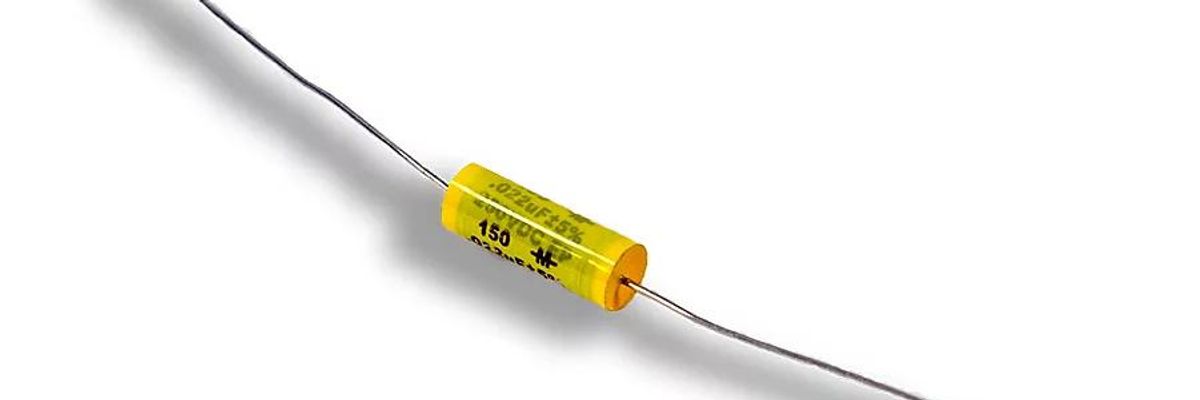
Mallory caps have a tubular shape and yellow color. You can find these caps in a lot of amps, and also inside guitars as tone caps. These caps have a great fat and punchy sound, pronouncing the mid frequencies while keeping the treble alive. This is the ideal tone cap for rock guys, and a lot of our customers choose them for their Les Pauls and SGs. They also sound great inside Fender guitars, and Leo Fender put these caps inside all of his "Music Man" amps, manufactured exclusively for him by the Plessi company. This is a good overall tone cap, and a great place to start; it seems to work well with both humbuckers and single coils. You can buy these caps new from a lot of companies.
Silver Mica caps
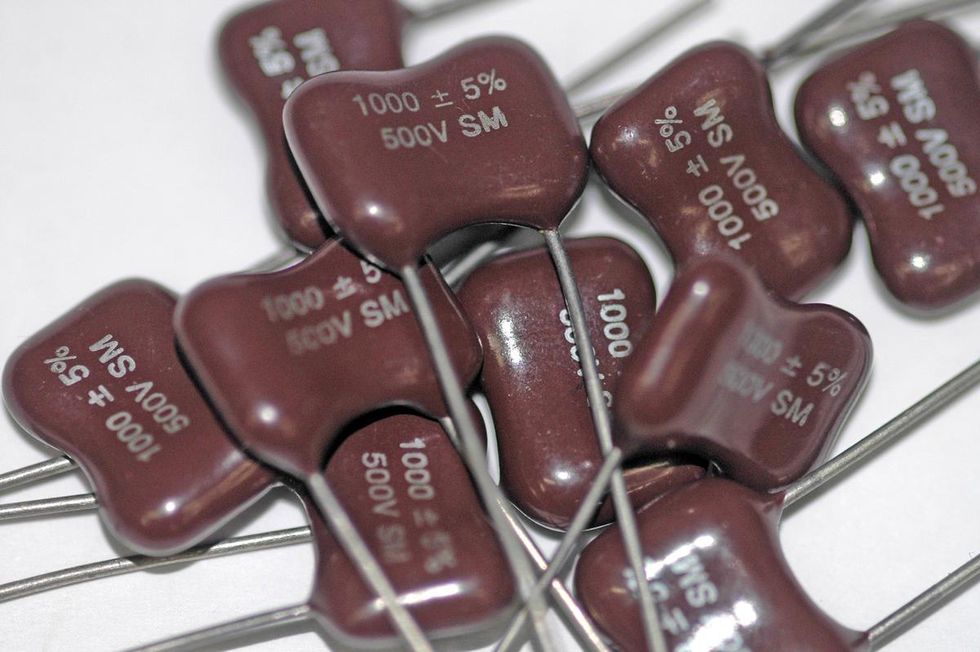
These caps have a typical "hump" in the middle of the body and can be found inside high-quality amps and stompboxes. They can also used as a hi-cut cap on the volume pot and, if you can find the correct value, also as a cap for the tone control. Higher values are often hard to find, large and very expensive, but still worth a try. They really sound excellent, without any coloration of the tone.
Styroflex caps
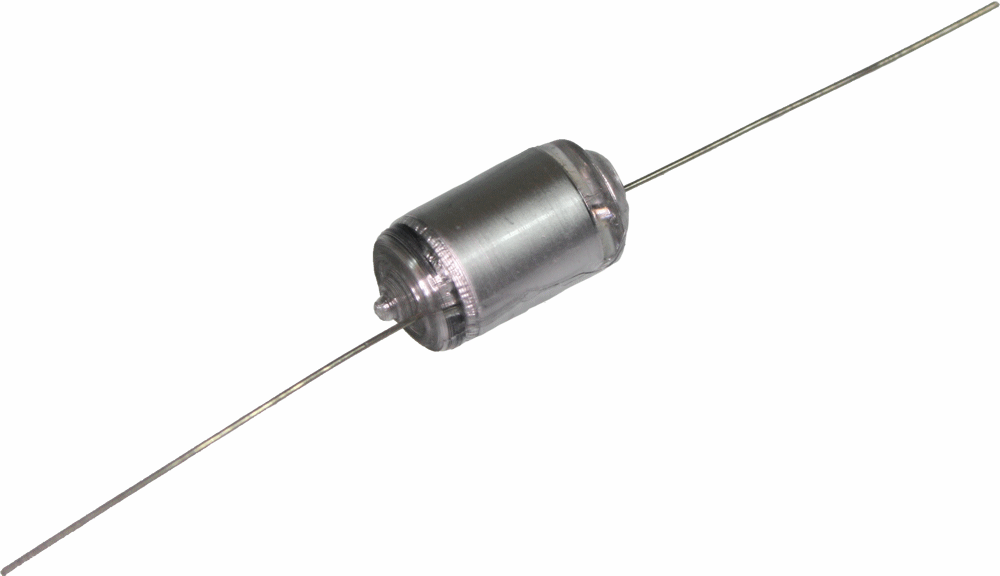
Styroflex caps are easy to identify because of their tubular shape and transparent housing. These caps are typical caps from the fifties and you can find them inside almost every radio and TV from the era. Some companies still make them today, and they're one of my favorite tone caps for maximum transparency of tone with absolutely no coloration. I prefer Styroflex caps inside semi-acoustic guitars and jazz boxes. You can find them on eBay, usually as assorted sets of different values, but they are also available from some companies out of actual production runs.
Oil-Paper caps
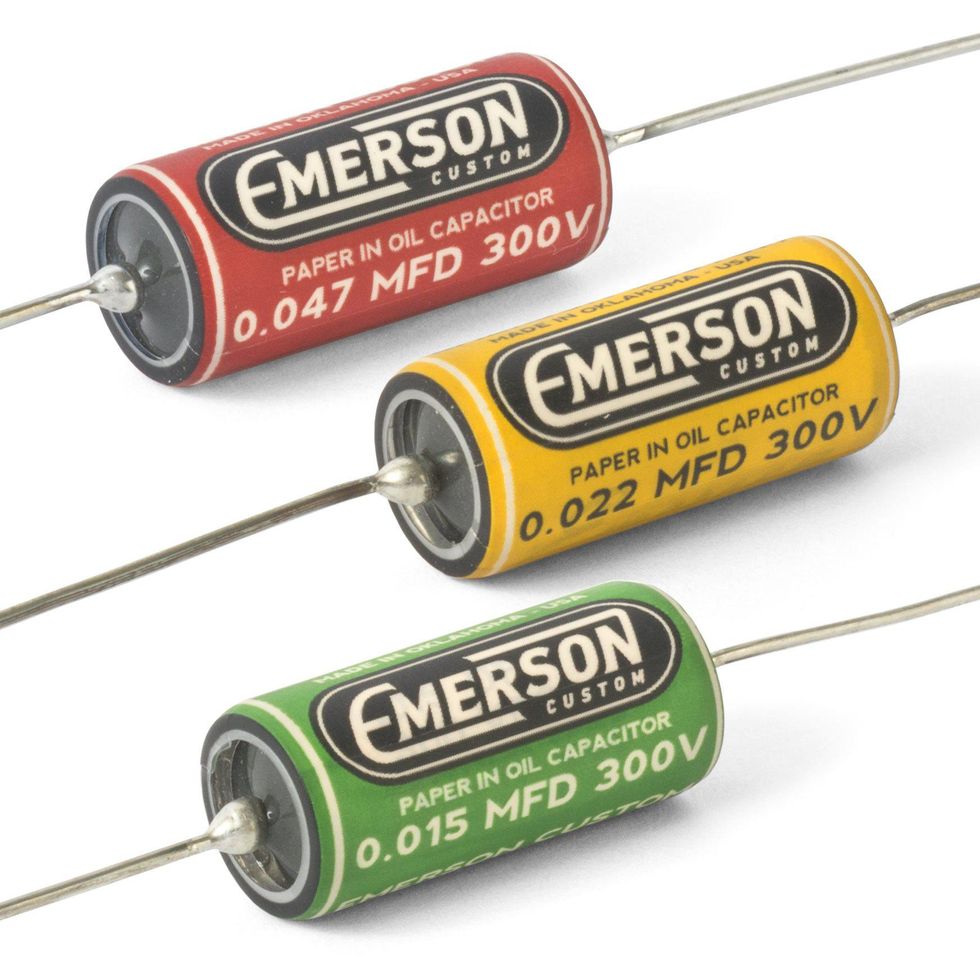
These caps from companies like Jensen can be found in high-end HIFI gear, as well as in high-quality guitar amps. They are very expensive but a lot of players swear by them. You can use them inside guitars if you have enough space for them; I tried them a while ago, and they sounded very similar to the Silver Mica and Styroflex caps -- definitely not a bad reference.
There are a lot more caps out there, like the Vitamin Q, Mustard caps and many others, however I think this is a good overview to help you choose which ones to try. Caps sound very different from one another, and they really affect the overall tone of the guitar – even with the tone pot fully opened. Remember, there is no right or wrong, it is simply a matter of individual taste. Don't be afraid to try cheap or historically incorrect caps with "incorrect" values; I never use the factory stock values, as I find them to be way too much. I prefer values from 3300 up to 6800pF, which makes the tone control much more useable. You can also mix up different types and values in one guitar; I have a Strat with a 6800pF Mallory cap for the bridge pickup only and a 3300pF Mallory cap for the middle and neck pickups together. Feel free to experiment and let your ears decide!
Next month we will get back to doing some guitar mods, this time discussing the wiring inside your axes.
[Updated 11/23/21]
- Cap and (Pot) Trade - Premier Guitar ›
- Mod Garage: Three Ways to Wire a Tone Pot - Premier Guitar ›
- Auditioning Tone Capacitors - Premier Guitar ›
We chat with Molly about Sister Rosetta’s “immediately impressive” playing, which blends jazz, gospel, chromaticism, and blues into an early rock ‘n’ roll style that was not only way ahead of its time but was also truly rockin’.
In the early ’60s, some of the British guitarists who would shape the direction of our instrument for decades to come all found themselves at a concert by Sister Rosetta Tharpe. What they heard from Tharpe and what made her performances so special—her sound, her energy—must have resonated. Back at home in the U.S., she was a captivating presence, wowing audiences going back to her early days in church through performing the first stadium rock ‘n’ roll concert—which was also one of her weddings—and beyond. Her guitar playing was incendiary, energetic, and a force to be reckoned with.
On this episode of 100 Guitarists, we’re joined by guitarist Molly Miller, who in addition to being a fantastic guitarist, educator, bandleader, and performing with Jason Mraz, is a bit of a Sister Rosetta scholar. We chat with Molly about Sister Rosetta’s “immediately impressive” playing, which blends jazz, gospel, chromaticism, and blues into an early rock ‘n’ roll style that was not only way ahead of its time but was also truly rockin’.
Featuring the SansAmp section, Reverb/Delay/Roto effects, and OMG overdrive, with new additions like a switchable Pre/Post Boost and Effect Loop. Pre-configured for the RK Killer Wail wah, this pedal offers versatile tones and unmatched flexibility.
Since the debut of the original RK5 in 2014, Richie’s needs have changed, both on and off the road. The RK5 v3 retains the same SansAmp section, Reverb/Delay/Roto section, and Richie’sSignature OMG overdrive. New features include a switchable Pre/Post Boost to beef up drive and distortion or increase the overall volume to punch up fills and solos, along with the addition of an Effect Loop. It has also been pre-configured to provide phantom power for Richie’s Tech21 Signature RK Killer Wail wah.
The all-analog SansAmp section of the RK5 focuses on clean tones within the tube amplifier sound spectrum. It includes 3-band active EQ, and Level and Drive controls. To dirty things up, you have the flexibility of using the Drive control, and the Boost function, or you can add overdrive from the OMG section. Or all three. Each method achieves different tones. The OMG section is based upon the Richie Kotzen Signature OMG pedal, which provides a wide range of overdrive, from clean to aggressive. You can add personality to a clean amp or use it for extra punch with a dirty amp tone. Controls include Drive for the overall amount of gain and overdrive and Tone with specialized voicing for adjusting the high-end and mid-range. A Fuzz switch changes the character and attack of the overdrive to a fuzz-style tone, making it thicker and woolier.
Other features include an independent foot-switchable Reverb witha choice of large and small“room sizes;” Tap Tempo Delay, which can be transformed into a rotating speaker effect; included Tech 21 Model #DC9 universal self-adjusting 9V DC power supply, with interchangeable international prong assemblies for use anywhere in the world. Anticipated availability: January 2025
For more information, please visit tech21nyc.com.
OM-balance and comfort suited for the fingerstylist on a budget.
Comfortably, agreeably playable. Balanced dimensions. Nice fretwork.
Lighter mahogany top looks less classically mahogany-like. Some compressed sounds in heavy-strumming settings.
$299
Guild OM-320
guildguitars.com
The Premier Guitar crew is spoiled when it comes to hanging out with nice flattops. But while those too-brief encounters with acoustics we can’t afford teach us a lot about the flattop at its most refined, they also underscore a disconnect between the cost and the acoustic guitar’s status as a true folk instrument of the people.
Guild’s OM-320, from the company’s new 300 series, sells for $299, which isn’t much more than a good-quality, entry-level flattop cost in the 1980s. Strikingly, there’s a lot of competition in this price class. Even so, the OM-320’s nice build quality and pretty tone in fingerpicking applications stand out in a very crowded price segment.
The United Guild of Deal-Seeking Pickers
Though Guild, in all its incarnations, has always made accessible guitars a part of their offerings, a $300 instrument with the company’s logo might give pause to players familiar with guitars from their various U.S. factories. Quality can be hit-or-miss on any guitar from any brand at the entry level. What’s more, a lot of guitars with different brand names come from just a few OEM facilities—lending a certain sameness on top of irregular quality. But the recent acquisition of Guild by Yamaha, who has a reputation for solid entry-level instruments, inspires confidence as far as these concerns go.
So, too, does the integrity of the OM-320 at the nuts-and-bolts level. I couldn’t find any overt lapses in quality control. And in many spots where that really counts, like the fretwork, the execution is especially good. Little details like the Guild logo overlay (rather than a simple decal) add a soupçon of luxury. So do the Guild-branded, Grover Sta-Tite-style butterbean tuners, which look stylish and feel sensitive and accurate.
“The neck inhabits a comfortable zone between C and D shapes that’s super agreeable and, at least in my case, a nice antidote for hand fatigue.”
Though the body is built from layered mahogany on the back and sides and a solid mahogany top, the latter is much lighter and amber- or honey-toned than the rich cocoa-hued mahogany tops you’d associate with a vintage Guild M-20, or, for that matter, theM-120 from the company’s contemporary Westerly line. As a result, you see a little more contrast in the grain and a little dimpling in certain sections of the wood. The lighter wood isn’t unattractive, it just looks less trad, if you’re chasing Nick Drake’s Bryter Layter style. If that’s important, you should adjust the “design/build” score appropriately.
Sit and Stay Awhile
Barring being covered in porcupine spines, almost any OM or 000 will qualify as a pure-comfort title finalist. It’s not too thick, too wide, nor too petite—a size and profile that also pays unique, civilized sonic dividends. Here, the OM body is complimented by a neck that feels like an especially natural match. I don’t have a bunch of inexpensive OMs on hand to compare, and there isn’t anything wildly unique about the shape, but the neck profile feels very proportionate to the body. It also, depending on your own sense of such things, inhabits a comfortable zone between C and D shapes that’s super agreeable and, at least in my case, a nice antidote for hand fatigue. The neck is not classically OM-like in terms of nut width. The M-320’s nut measures 1 13/16", which is typical of a 000, rather than the 1 3/4" associated with OMs. The extra width, of course, would make the guitar more appealing to some fingerstylists that need the space. At no point, however, did I feel anything close to cramped; it’s just very comfortable.
The combination of layered back and sides, OM/000 dimensions, and mahogany mean the OM-320 feels and sounds less than super-widescreen in terms of tone spectrum and power. Nevertheless, it sounds balanced and pretty—particularly with a droning, dropped 6th string and other more-elastic tunings where the guitar can exercise the lower extremes of its voice. Tuning to standard has the effect of highlighting midrange emphasis, which can get boxy and render the 3rd and 4th strings a bit less potent and present. That said, it’s still balanced and almost never collapses into a distorted harmonic blur. The bottom end maintains an appealing growl and, as long as you use a gentler picking approach, you can use the highest four strings in very dynamic ways. Using a capo emphasizes other cool, high-mid-focused voices in the guitar that coexist well with most strumming approaches.
The Verdict
Inexpensive guitars that feel great can make up for a lot of shortcomings in tone. But the OM-320’s deficiencies in the latter regard are few, and some perceived limitations, like midrange emphasis, are intrinsic to guitars with OM dimensions. So, while forceful strumming is not the OM-320’s strength, the comfortable playability might just lead you to those places anyway. And if you compensate accordingly with touch dynamics, you can conjure many sweetly chiming tones that might sound extra sweet given the bargain price
Featuring vintage tremolos, modern slicer effects, and stereo auto-panners, the update includes clever Rate and Tempo controls for seamless syncing and morphing.
Today Kemper announces the immediate availability PROFILER OS 12.0 including the highly anticipated collection of advanced Tremolo and Slicer FX for the entire range of KEMPER PROFILER guitar amps.
The Collection features three vintage tremolos, two modern slicer effects, and two stereo auto-panners, that have been derived from the slicer effects. They all feature a clever Rate and Tempo control system, that allows for syncing the tremolo to the song tempo, retriggering the timing by simply hitting the TAP switch, and changing or morphing the tremolo rate to different note values,
The new Advanced Tremolo Modules in Detail
- The Tube Bias Tremolo is the familiar Tremolo in the Kemper Profilers. Formally named "Tremolo“ and available in the PROFILERs since day one, it is a reproduction of the famous Fender Amp tremolos from the 50‘s. Placed in front of the amp it beautifully interacts with the amp distortion.
- The Photocell Tremolo dates back to the 60‘s and features a steeper pulse slope, and its width varies with the intensity.
- The Harmonic Tremolo also dates back to the 60‘s and was introduced by Fender. The low and high frequencies alternate with the tremolo rate.
- The Pulse Slicer is a modern slizer or stutter effect that will continuously transition from the smoothest sine wave to the sharpest square wave, using the "Edge“ parameter. The "Skew“ parameter changes the timing of the high level versus the low level, sometimes also called pulse width or duty cycle.
- The Saw Slicer creates a ramp like a saw wave. The saw wave has a falling ramp when "Edge“ is at full position, and a rising edge at zero position. Towards the middle position a rising and falling ramp are forming a triangle wave. The „Skew“ parameter changes the slope of the rising and falling ramp from a linear trajectory to a more convex or concave shape.
- The Pulse Autopanner and the Saw Autopanner are derivates from their respective Slicers, they spread their signals in the stereo panorama. The "Stereo“-control parameter is included in many effects of the PROFILER. Here, it introduces a novel "super-stereo" effect that lets the Autopanner send the signal well outside the regular stereo image. This effect works best if you are well positioned in the correct stereo triangle of your speakers. When you move the “Stereo” soft knob beyond the +/-100% setting, the super-stereo effect comes into place, reaching its maximum impact at +/-200%.
- A single press on the TAP button at the beginning of the bar will bring the rhythmic modulation effects, such as Tremolo or Slicer, back into sync with the music without changing the tempo. The sync will happen smoothly and almost unnoticeable, which is a unique feature. Of course, tapping the tempo is possible as well.
- Modulation Rate - The “Rate” control available in many modulation effects is based on a special philosophy that allows continuous control over the speed of the modulation and continuous Morphing, even when linked to the current tempo via the To Tempo option. The fine Rate resolution shines when seamlessly morphing from, e.g., 1/8 notes to 1/16 notes or triplets without a glitch and without losing the timing of the music.



